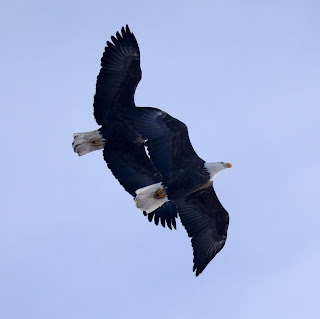The timing was almost perfect because it was during the mating and nesting period, and many birds had already hatched their eggs. The following photos are just a few of the hundreds taken in one week, but they're my favorites and I hope they'll be yours as well.
The stars of the Wakodahatchee Wetlands (WW) were the baby Egrets. One can't look at these chicks and not think of their dinosaur ancestors (or my cousin Elmer from Smackover, Arkansas). They're totally dependent upon their mom and pop for food and protection, much like millennials.
This rather ugly chick is a Wood Stork, and when you look at the mom you know immediately where the chick gets its looks.
But Mother Nature works her wonders by giving the Wood Stork grace and beauty when in flight, as the next photos will prove.
There were many Wood Storks at WW and watching them fly in groups was like a choreographed ballet.
The following photos were taken at Green Cay Wetlands (GCW):
This is the Roseate Spoonbill. (Gee, I wonder why they're called Spoonbill?)
According to the Cornell Lab of Ornithology, the Spoonbill is not related to the Pink Flamingo. Their color is due to the food they eat, normally crustaceans like shrimp, mollusks, snails and Twinkies.
Trivia note: The pink eyes of the Spoonbill get pinker as they age.
This is an adult breeding Cormorant. Note the beautiful aquamarine eyes. The cormorant is a diving bird and is often confused with the Anhinga (next photos).
The GCW birds are very used to being close to people and often, like this one, perch on the rails of the boardwalk within a few feet of passersby.
The following photos are of the Anhinga bird, also a fish-eating bird that dives for its dinner. The long, snake-like neck is why the Anhinga is also called Snake Bird, because when swimming, only the neck is visible and looks like a snake.
This pair of Anhinga birds are immature, hence the beige necks. They did a dance as I took photos, probably mistaking me for a talent scout for a TV show.
Anhingas have pointy beaks, unlike the Cormorant which has a curved beak at the end. This feature makes it easier to identify the difference between the two.
This Anhinga had a bit of an attitude, I think, engaging me in a "stare-down." Need I say that he won and then flew away triumphantly?
I saved the best for last. This is a male Painted Bunting, often considered the most beautiful bird in the world. We don't have the pleasure of seeing this bird in Wisconsin because it hates cold weather and does not like paying high taxes.
Several Buntings were at the feeders, but I wanted to photograph one in a more natural setting.
I had to wait a long time to finally get my wish.


































